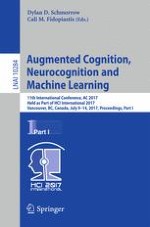2017 | OriginalPaper | Chapter
Adapting Human-Computer-Interaction of Attentive Smart Glasses to the Trade-Off Conflict in Purchase Decisions: An Experiment in a Virtual Supermarket
Authors : Jella Pfeiffer, Thies Pfeiffer, Anke Greif-Winzrieth, Martin Meißner, Patrick Renner, Christof Weinhardt
Published in: Augmented Cognition. Neurocognition and Machine Learning
Publisher: Springer International Publishing
Activate our intelligent search to find suitable subject content or patents.
Select sections of text to find matching patents with Artificial Intelligence. powered by
Select sections of text to find additional relevant content using AI-assisted search. powered by
